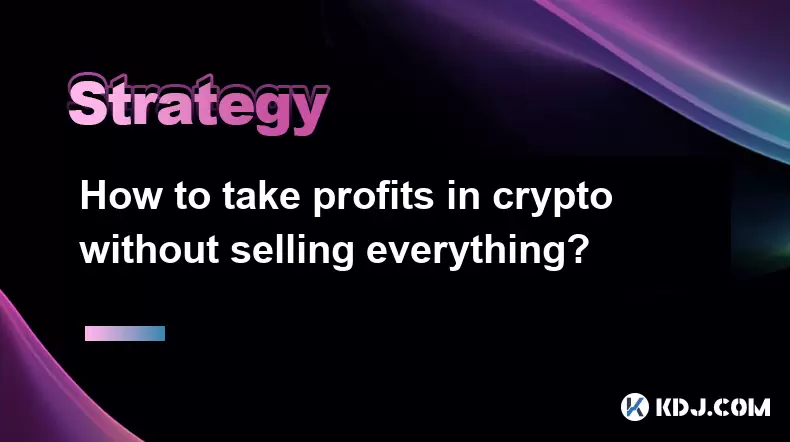-
 bitcoin
bitcoin $122288.232522 USD
0.16% -
 ethereum
ethereum $4480.662914 USD
-0.22% -
 xrp
xrp $2.962747 USD
-2.32% -
 tether
tether $1.000120 USD
-0.05% -
 bnb
bnb $1145.654223 USD
-2.07% -
 solana
solana $227.105217 USD
-1.67% -
 usd-coin
usd-coin $0.999548 USD
-0.02% -
 dogecoin
dogecoin $0.250875 USD
-2.04% -
 tron
tron $0.340654 USD
-0.49% -
 cardano
cardano $0.837968 USD
-2.52% -
 hyperliquid
hyperliquid $48.960449 USD
0.06% -
 chainlink
chainlink $22.049280 USD
-1.33% -
 ethena-usde
ethena-usde $1.000404 USD
0.02% -
 sui
sui $3.586212 USD
0.20% -
 avalanche
avalanche $29.894916 USD
-4.18%
How to take profits in crypto without selling everything?
Strategic profit-taking in crypto, like partial selling and trailing stops, lets investors lock in gains while keeping upside potential alive.
Jul 15, 2025 at 05:49 pm

Understanding Profit-Taking in the Crypto Market
Taking profits in cryptocurrency doesn't necessarily mean selling your entire position. Many traders and investors aim to secure gains while still maintaining exposure to potential future price increases. The key lies in understanding how to strategically manage your portfolio without liquidating all holdings. This approach is especially useful for those who believe in the long-term value of a particular asset but want to lock in some returns.
Profit-taking strategies allow investors to reduce risk while preserving upside potential. These methods can vary based on market conditions, investment goals, and individual risk tolerance. It's crucial to have a clear plan before entering any trade or investment, especially in the volatile crypto space.
Partial Selling as a Strategic Move
One of the most straightforward ways to take profits without selling everything is by employing partial selling. This involves selling a percentage of your holdings once a specific profit target is reached. For instance, if you bought Bitcoin at $20,000 and it rises to $30,000, you might decide to sell 50% of your position to lock in half the gain while keeping the remaining 50% for further growth.
- Determine your initial entry point and set realistic profit targets.
- Decide what percentage of your holding you're comfortable selling at each milestone.
- Use limit orders to automate partial sales at desired price levels.
- Review your strategy regularly and adjust based on new information or market shifts.
This method allows for flexibility and control over your capital allocation. It balances the need for realized profits with the desire to stay invested in high-growth assets.
Utilizing Trailing Stop Orders
Another effective way to secure profits without fully exiting a position is by using trailing stop orders. This type of order follows the market price by a set percentage or dollar amount. If the price starts to fall after reaching a peak, the trailing stop will trigger a sale once the specified threshold is breached.
Trailing stops help protect gains while allowing your investment to continue participating in upward trends. They are particularly useful during highly volatile periods when prices can swing dramatically within short timeframes.
Here’s how to implement this strategy:
- Select a trailing percentage or fixed amount that aligns with your risk appetite.
- Place the trailing stop order on your preferred exchange platform.
- Monitor how the order behaves as the price fluctuates.
- Be aware of slippage risks in low-liquidity markets.
This automated tool helps eliminate emotional decision-making and ensures you don’t miss an exit opportunity due to market timing issues.
Hedging Your Position
For more advanced traders, hedging offers a sophisticated way to take profits without selling your entire crypto position. Hedging typically involves taking an offsetting position in a related asset or derivative, such as futures contracts or options.
Hedging can protect against downside risk while allowing you to maintain ownership of your original assets. This method is commonly used by institutional players but is increasingly accessible to retail investors through platforms offering derivatives trading.
To hedge effectively:
- Evaluate the correlation between the hedging instrument and your primary holding.
- Choose appropriate derivatives like put options or short futures contracts.
- Understand the costs involved, including premiums and margin requirements.
- Continuously assess the effectiveness of your hedge and make adjustments as needed.
While this strategy requires more knowledge and experience, it provides a powerful mechanism for managing risk and locking in profits.
Rebalancing Your Portfolio
Portfolio rebalancing is another strategic method for realizing profits without selling everything. As certain assets grow disproportionately compared to others, they may represent a larger portion of your total portfolio than initially intended. Rebalancing involves selling part of the outperforming asset to bring your portfolio back to its target allocation.
Rebalancing not only secures gains but also maintains a diversified and balanced investment approach. It’s especially useful for long-term holders who want to remain exposed to different sectors within the crypto ecosystem.
Steps to rebalance your portfolio:
- Define your ideal asset allocation percentages based on your investment strategy.
- Regularly review your portfolio to identify overweight positions.
- Sell a portion of the overrepresented asset and reinvest in underrepresented ones.
- Set a schedule (e.g., quarterly or semi-annually) for consistent rebalancing.
This disciplined approach ensures that no single asset dominates your portfolio, helping you maintain a sustainable and risk-managed investment profile.
Frequently Asked Questions
Q: Can I take profits in crypto without triggering taxes?A: In most jurisdictions, any sale of cryptocurrency is considered a taxable event. However, strategies like staking, yield farming, or receiving airdrops may generate income without immediate disposal of your principal holdings.
Q: Is there a best time to start taking profits?A: There is no universal “best” time, but many investors use technical indicators, fundamental analysis, or historical performance benchmarks to determine optimal exit points.
Q: How do I know what percentage of my holdings to sell for profit?A: It depends on your personal risk tolerance, investment goals, and market outlook. Some investors follow rules like selling 25% every time a 50% gain is achieved, while others prefer dynamic adjustments.
Q: Are there tools or platforms that help automate profit-taking strategies?A: Yes, several exchanges and third-party platforms offer features like limit orders, trailing stops, and portfolio alerts to assist with automated profit management.
Disclaimer:info@kdj.com
The information provided is not trading advice. kdj.com does not assume any responsibility for any investments made based on the information provided in this article. Cryptocurrencies are highly volatile and it is highly recommended that you invest with caution after thorough research!
If you believe that the content used on this website infringes your copyright, please contact us immediately (info@kdj.com) and we will delete it promptly.
- BlockDAG, DOGE, HYPE Sponsorship: Crypto Trends Shaping 2025
- 2025-10-01 00:25:13
- Deutsche Börse and Circle: A StableCoin Adoption Powerhouse in Europe
- 2025-10-01 00:25:13
- BlockDAG's Presale Buzz: Is It the Crypto to Watch in October 2025?
- 2025-10-01 00:30:13
- Bitcoin, Crypto, and IQ: When Genius Meets Digital Gold?
- 2025-10-01 00:30:13
- Stablecoins, American Innovation, and Wallet Tokens: The Next Frontier
- 2025-10-01 00:35:12
- NBU, Coins, and Crypto in Ukraine: A New Yorker's Take
- 2025-10-01 00:45:14
Related knowledge

Practical parameter settings for a Bitcoin multi-timeframe moving average system
Sep 18,2025 at 10:54pm
Optimizing Timeframe Combinations for Bitcoin Trading1. Selecting appropriate timeframes is crucial when building a multi-timeframe moving average sys...

How can I filter out false breakouts in Dogecoin high-frequency trading?
Sep 22,2025 at 01:00am
Understanding False Breakouts in Dogecoin Trading1. A false breakout occurs when Dogecoin's price appears to move beyond a defined support or resistan...

Techniques for identifying tops and bottoms in the Bitcoin on-chain NVT model
Sep 20,2025 at 07:54pm
Understanding the NVT Model in Bitcoin Analysis1. The Network Value to Transactions (NVT) ratio is often described as the 'P/E ratio' of the cryptocur...

What does the surge in open interest in Bitcoincoin futures mean?
Sep 20,2025 at 11:18pm
Understanding the Surge in Dogecoin Futures Open Interest1. A surge in open interest within Dogecoin futures indicates a growing number of active cont...

How can I use the Ethereum USDT premium to gauge market sentiment?
Sep 18,2025 at 11:55pm
Understanding the Ethereum USDT Premium1. The Ethereum USDT premium refers to the price difference between USDT (Tether) traded on Ethereum-based plat...

What should I do if Ethereum staking yields decline?
Sep 20,2025 at 06:18am
Understanding the Causes Behind Declining Ethereum Staking Yields1. The Ethereum network transitioned to a proof-of-stake consensus mechanism with the...

Practical parameter settings for a Bitcoin multi-timeframe moving average system
Sep 18,2025 at 10:54pm
Optimizing Timeframe Combinations for Bitcoin Trading1. Selecting appropriate timeframes is crucial when building a multi-timeframe moving average sys...

How can I filter out false breakouts in Dogecoin high-frequency trading?
Sep 22,2025 at 01:00am
Understanding False Breakouts in Dogecoin Trading1. A false breakout occurs when Dogecoin's price appears to move beyond a defined support or resistan...

Techniques for identifying tops and bottoms in the Bitcoin on-chain NVT model
Sep 20,2025 at 07:54pm
Understanding the NVT Model in Bitcoin Analysis1. The Network Value to Transactions (NVT) ratio is often described as the 'P/E ratio' of the cryptocur...

What does the surge in open interest in Bitcoincoin futures mean?
Sep 20,2025 at 11:18pm
Understanding the Surge in Dogecoin Futures Open Interest1. A surge in open interest within Dogecoin futures indicates a growing number of active cont...

How can I use the Ethereum USDT premium to gauge market sentiment?
Sep 18,2025 at 11:55pm
Understanding the Ethereum USDT Premium1. The Ethereum USDT premium refers to the price difference between USDT (Tether) traded on Ethereum-based plat...

What should I do if Ethereum staking yields decline?
Sep 20,2025 at 06:18am
Understanding the Causes Behind Declining Ethereum Staking Yields1. The Ethereum network transitioned to a proof-of-stake consensus mechanism with the...
See all articles










































































